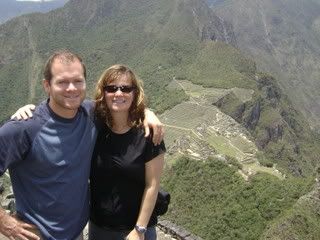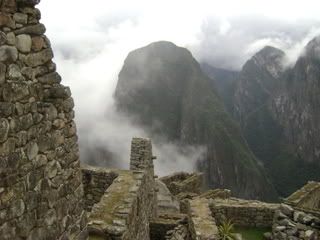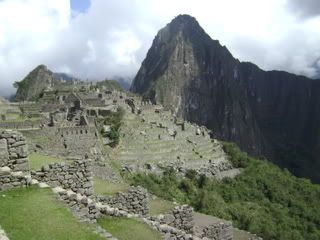When it comes to ruins here in Peru, they run quite the racket and the whoel thing left me with mixed feelings. If you want to see Machupicchu independently, here´s the breakdown:
·backpacker train from Cuzco to Aguas Calientes: $96
·bus from Aguas Calients to Machupicchu and back: $14
·entry to ruins: $42
·cost to use the toilet at park headquarters: 30 cents.
It was the fee to use the toilet, after I had paid $42 to get in, that really left a bad taste in my mouth. But regardless, Machupicchu is likely among the most expensive wonders in the world to visit.
So is it worth it? Hard to say. The ruins themselves are not terribly interesting, in my opinion, especially when compared to some other places I´ve been like Tikal (Guatemala), Copan (Honduras) and Angor Wat (Cambodia). What is not an arguable point, however, is the grandeur of the setting.
(Here´s Laura and Bill atop Waynapicchu looking down on the ruins:)

The train from Cuzco to Aguas Calientes switchbacks to get out of Cusco and climb up to 11,000 feet before ambling through pastoral valleys and small towns and beginning a descent into a radical canyon. The canyon opens somewhat before closing further and picking up a raging river. The elevation over the course of four hours drops from 11,000 feet to 6,300 feet, along the way are stupendous snowcapped mountains.
We arrived in Aguas Calientes about noon. We had heard a lot of bad things about this town but it turned out to be pretty cool -- totally isolated, no cars, big river running right through town, and some of the most incredible mountains I´ve ever seen.

The hassle factor there was pretty high and we practically got chased out of town by touts wanting us to stay at thier hotels. We chose the one who hassled us the least and set out on a hike.
The hike was up a peak facing Machupicchu. This photo, taken from the ruins the next day, shows the mountain. Climbing it involves tackling a long series of wooden ladders and legitimate rock scrambling. It took about 90 minutes to get to the top.

We were up early the next morning to save $14. The tourist bus to the ruins is $7 each way, but you can forgo that by hiking a trail which runs between the road´s endless switchbacks. Laura and I left at 5 a.m. and got to the ruins, sheathed in fog, at about 6:30. Luckily we found Bill. We then got in line to get tickets to climb Waynapicchu, the steep peak that backs the ruins. The climb is free, but they only let up the first 400 who make it to the base. The climb was more ladders, steep rocks, a narrow Inca tunnel and then a scramble to get to the summit.
Waynapicchu in the background:

By 2 p.m. we were pretty wasted. Laura and Bill rode the bus down while I took one short hike, to a place called Temple of the Sun, which has classic views down on the ruins.
On Wednesday we had an easy morning and caught the train partway back to Cuzco, getting off in Ollaytatambo, a small and very pleasant town. When I thought of the ruins in Peru I just thought of a handful of the popular ones, but the whole countryside is filled withe ruin´s; on a two hour trainride we passed a dozen or more, some of which were simple Inca terraces and others of which were teraces matched with walls, trails and forts. Ollaytatambo was no disappointment; not only was it extensive but it was backed by snowcapped peaks. We stayed in a very nice hotel for not a lot of money and had good Mexican food for dinner.
Bill slept quite a bit while he was with us, and I think it drove home something I try and tell people: traveling is not easy. One of the most difficult things is the fact that we never go to the same place twice. That means we never know where the bus station is, where our hotel will be, where is a decent place to eat, what streets are unsafe at night, or a million other things. Also serving to further exhaust the traveler is the fact that in many places a decent night´s rest is pretty hard to come by, beds can be awful, food of negligible nutritious value, hotels noisy, and etc. etc. etc. So it´s hard work, except when it´s easy.
Wednesday night, right during our Mexican dinner, I started to feel pretty lousy. I had been feeling weird on and off for a couple of days but at night my stomach started to cramp and I got the dreaded sulfur burps.
A few years ago, traveling in Vietnam, I got pretty sick -- travelers stuff. The hallmark of the sickness was burps that tasted like sulfur. It´s fairly disgusting. After suffering through this for a while someone mentionned that sulfur burps were a sign of girardiasis. Girardiasis is a parasite that hangs out in polluted water, and even though we filter all the water we drink I suppose you can still ingest some through juices, vegetables and even accidentally in the shower.
The cure for girardiasis is a drug called flagyll. It´s a superstrong antibiotic available without prescription in countries like those where you´re most likely to get it.
I felt pretty awful Wednesday night and most of Thursday, worrying about my sulfur burps, until Laura said we should just get flagyll and not wait for it to get worse. Well, first pharmacy we went to had it for less than a dollar a pill. I took two last night and one this morning and the sulfur burps are gone. Yeah!
3 comments:
Glad you are feeling better. Traveling can be hard even when you have hotels lined up and suggestions for food, so I admire you guys for the way you travel. It takes a strong person to take on what you and Laura are doing.
Ah, Flagyl, my favorite Peace Corps dessert! You must have it upon the right dosage. OD-ing on that stuff is worse than giardia itself. -e
Laura is one smart woman! You should listen to her more often!
Perhaps even loosen the purse strings enough to keep a supply of the pills on hand.
Post a Comment